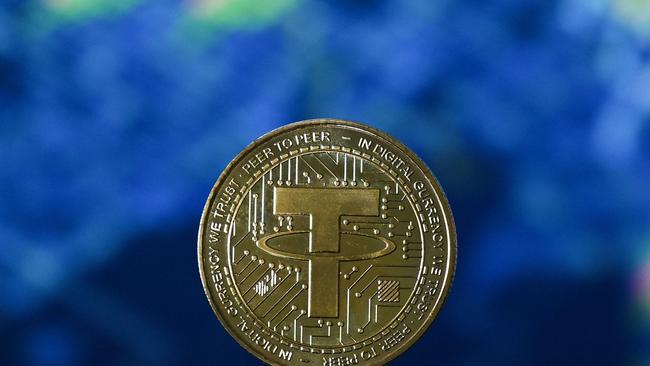Cryptocurrency TerraUSD plunges as investors bail
TerraUSD, part of a group of cryptocurrencies that are favoured for their stability, nosedived overnight to trade at less than a quarter of its usual $US1 value.

A sell-off in a cryptocurrency that was supposed to be pegged to $US1 accelerated Wednesday, briefly sending its price to less than a quarter of that value.
TerraUSD traded as low as 23 US cents, according to data from CoinDesk. As of about 5pm ET, it had rebounded partially to about 67 US cents in volatile trading.
A stablecoin, this breed of cryptocurrencies had gained favour among traders for being the one part of the crypto universe that was known for its stability. While the most popular stablecoins maintain their levels with assets that include dollar-denominated debt and cash, TerraUSD is what is known as an algorithmic stablecoin, which relies on financial engineering to maintain its link to the dollar.
The break in TerraUSD’s peg began over the weekend with a series of large withdrawals of TerraUSD from Anchor Protocol, a sort of decentralised bank for crypto investors.
Anchor Protocol is built on the technology of the same Terra blockchain network that TerraUSD is based on. It had been a major factor in the growth of the stablecoin in recent months by allowing crypto investors to earn returns of nearly 20 per cent annually by lending out their TerraUSD holdings.
At the same time, TerraUSD was also sold for other stablecoins backed by traditional assets through various liquidity pools that contribute to the stability of the peg, as well as through cryptocurrency exchanges. The sudden outflow of money spooked some traders who began selling TerraUSD and its sister token Luna. Before its peg was broken, TerraUSD was the third-largest stablecoin, with a total market value of $US18bn.
TerraUSD’s fall to 23 US cents at around 3:30am ET marked a 70 per cent drop from its value 24 hours earlier, according to CoinDesk.
Even as TerraUSD began regaining some value after hitting its low, Luna continued to fall. The token was down about 95 per cent from the previous 24 hours at around 5pm ET, trading at $US1.16.
“I understand the last 72 hours have been extremely tough on all of you – know that I am resolved to work with every one of you to weather this crisis, and we will build our way out of this,” wrote Do Kwon, the South Korean developer who created TerraUSD, on Twitter on Wednesday.
Stablecoins have surged in popularity the past two years and now act as the grease that moves the gears of the cryptocurrency ecosystem. Traders prefer to buy coins such as bitcoin, ether and dogecoin using digital assets that are pegged to the dollar because when they buy or sell, the price is only moving on one side. They also allow for fast trading without the settlement times associated with government-issued currencies, which can take days.
The price of bitcoin fell to $US28,314.54 Wednesday, down 8.5 per cent from its 5pm ET level Tuesday. It has lost about 28 per cent of its value over the past seven days. It has lost about 24 per cent of its value over the past week alone.
In the past, TerraUSD maintained its $US1 price by relying on traders who acted as its backstop. When it fell below the peg, traders would burn the stablecoin – removing it from circulation – by exchanging TerraUSD for $US1 worth of new units of Luna. That action reduced the supply of TerraUSD and raised its price.
Conversely, when TerraUSD’s value rose above $US1, traders could burn Luna and create new TerraUSD, thus increasing the supply of the stablecoin and lowering its price back toward $US1.
Such a model has drawn criticism because it relies on people’s collective willingness to support the cryptocurrency. Without that, the stablecoin can sink quickly, in what industry participants have described as a “death spiral.” Martin Hiesboeck, head of blockchain and crypto research at digital money platform Uphold, compared what is happening with TerraUSD and Luna to a bank run. “People don’t trust it anymore, they’re running for the exit,” he said.
Mr Kwon, the TerraUSD creator, also co-founded the Luna Foundation Guard, a non-profit that has been helping to support TerraUSD and maintain its peg.
Earlier this week, the foundation said it lent $US750m of bitcoin to trading firms to protect the stablecoin’s peg. Blockchain records of the foundation’s wallet show that it no longer holds bitcoin in that account.
The previous day, TerraUSD’s value had rebounded to about 90 US cents after falling to 61 cents, while Luna had also recovered after plunging.
Senator Pat Toomey, the top Republican on the Senate Banking Committee and an enthusiastic booster of cryptocurrencies in Congress, told reporters during a conference call Wednesday that the Terra sell-off has refocused lawmakers’ attention on stablecoins.
The Wall Street Journal


